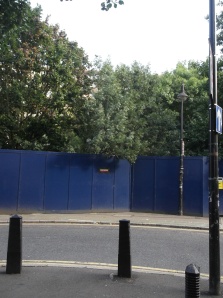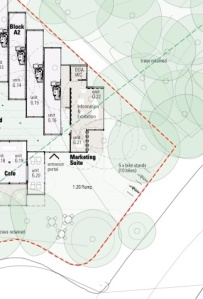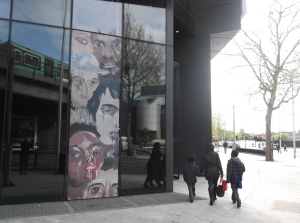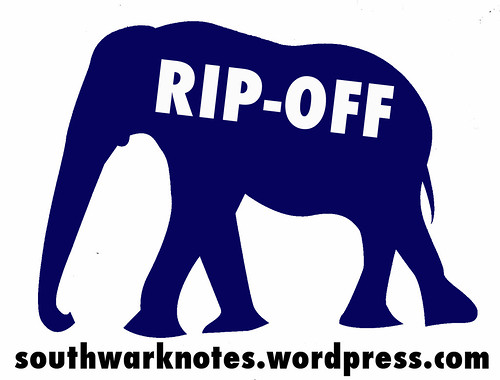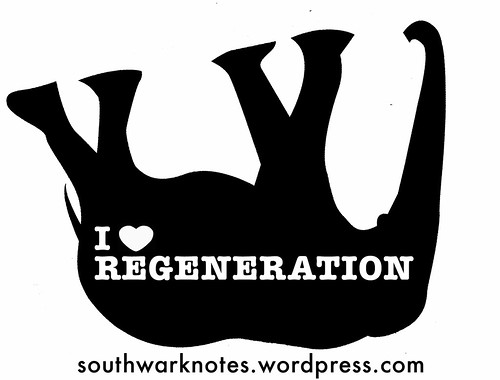Empowerment for Surrender? A Response from The Artists to Southwark Notes
We would like to thank Southwark Notes on three counts:
- For their serious engagement with the politics of the People’s Bureau (see our article ‘Empowerment For Surrender: People’s Bureau, Engaged Art & The Elephant’)
- For raising a number of significant questions, and
- For the opportunity to respond.
We share many of the concerns of the authors. In particular we:
- Acknowledge the tension between the ‘belief system’ of corporate capital, and the values of social capital and the global commons, which underpin the People’s Bureau.
- Recognize the risk that in co-operating with a developer such as Delancey (including by receiving funding) we are co-opted to their purposes.
- Suspect that Delancey is more concerned with creating the appearance of community engagement and consultation, than with its substance.
Indeed it is largely on the basis of such concerns that we have decided against accepting further funding from Delancey.
We agree with the authors that:
“For us this is less an argument about taking developer money for projects but more the thorny question of what you actually critically do and say from that money.”
We hoped that working with Delancey would present opportunities for influence. However, some of their more recent actions have caused us to question that position.
Where we respectfully disagree with the authors is in their depiction of the People’s Bureau as ‘Empowerment for Surrender’. They overlook the subversive content of the project, describing it in terms, which imply it is little more than a trivial distraction and ‘museumisation’:
Operating out of a customised traders’ mobile cart first given to them by Delancey, the artists began by organising fun and playful activities, as well as workshops and skills-exchange sessions (‘…sewing, knitting and crocheting, pedicure, massage, facials, gardening, baking, vegetable fermentation, light workshop, embroidery, dream-catchers making‘, etc). The aim was to collect local E&C knowledge and memories: stories, drawings and photos.
This analysis completely misses the point of the project, People’s Bureau is intended as a rallying cry against the crude and merciless logic of corporate capital. It is intended to distill and to highlight:
1) The role and function of public space and public commons.
2) The capacity of the community to self-organise.
3) Economic alternatives to cycles of consumption and destruction that, through emissions of greenhouse gases, now threaten the future of life on earth.
There is, of course, a battle to be fought for the Elephant & Castle in the here and now. We do not claim that the People’s Bureau is at the front line of that battle. What we hope, however, is that by reminding people of what is at stake and by focusing attention on the oasis of social capital that is under threat, we give others a vision of something worth fighting for.
We are artists and not experts in legal or planning processes. We would, however, welcome a discussion with the authors about how we might work together to promote greater understanding of these processes. If individuals and citizens platforms come together to make their voices heard, co-operating and exchanging skills, we can ensure there is no meek surrender to the forces of blind capital.
People’s Bureau,
December 2016
Note: We have worked to try and improve the online representation of our work at Elephant and Castle online by putting together peoplebureau.co.uk. We hope the project is better evidenced here and clarifies our point of view more clearly.
Also we invite you to a public discussion on February 2 (venue to be confirmed), to converse about this matter and the wider issues around socially engaged arts practice.
A Second Response from Southwark Notes to People’s Bureau
Southwark Notes would like to thank People’s Bureau for their response to our recent article ‘Empowerment For Surrender: People’s Bureau, Engaged Art & The Elephant’ and for the recognition that we are ‘raising a number of significant questions’. While we recognise the People’s Bureau’s willingness to engage in an exchange, we think that there are some fundamental issues that still need to be addressed. We’d therefore like to briefly respond in turn.
People’s Bureau: ‘we suspect that Delancey is more concerned with creating the appearance of community engagement and consultation, than with its substance’.
1. Delancey DV4 is an aggressive multi-billion pound real estate investment company registered in a tax haven. Ourselves, many investigative journalists and local groups have been pointing this out for years:
35% Campaign on Delancey developments at Elephant
35% Campaign on Delancey Shopping Centre proposals
Private Eye on Delancey
Southwark Notes on Delancey and Shopping Centre
Gunnersbury Park Campaign on Delancey
Delancey, by nature of their business, are interested in one bottom line: how big a profit they can wring from the Shopping Centre redevelopment through the construction of private homes on the site. They have been set on demolition and displacement of local shops and community since they bought the Shopping Centre in December 2013. Two months later in February 2014, they announced ‘The first thing is that we are looking to demolish the centre and redevelop it’. People’s Bureau were then part of Delancey first public consultation in July 2015 where demolition was clearly signaled.
People’s Bureau state that they have moved from a position of thinking that they could accept Delancey’s money and have ‘opportunities for influence’ with them, to one of disillusionment with Delancey’s intentions. They state now that ‘some of their more recent actions have caused us to question that position’. Although we feel that trust in Delancey was always somewhat naïve for critical artists to have, we recognise the role of learning from experiences and criticism and we welcome People’s Bureau new-found realisation. We presume as demolition looms ever nearer that Delancey is now winding down it’s funding of local artists and other groups. What interests us now is: How has the Bureau communicated this let down to Delancey and how has their formal relationship changed? Making the details of their break with Delancey public would be very interesting not only for local campaigners but also to others in the artistic and creative community who might be faced with the same contradictions People’s Bureau have moved through.
So a vital question for us is how People’s Bureau will now use the special relationship they developed over the years with Delancey, to point out the phony nature of their consultation process? As Delancey’s Elephant Shopping Centre application has just been made public, this is a perfect moment to delegitimise the faux ‘community consultation’ and push for real and tangible community benefits alongside local campaigns.
2. Our critique of People’s Bureau’s work comes from both an early engagement with a few of their events and a close observation of their later activities. Whilst we have not directly engaged with the workshops offered more recently around the People’s Bureau cart, we believe our participation and observation gives us enough understanding to analyse, reflect and comment upon their art practice.
We again question the use of some terms used to describe People’s Bureau’s practice. We fail to see how People’s Bureau’s work engages with debates about ‘the commons’. The Elephant and Castle Shopping Centre is a privately-owned commercial space, and doing workshops that are open to the public does not necessarily equate much with facilitating a deeper and practical reflection on the use of public space. It is a further leap to say the Bureau is visioning and working towards a ‘commons’ as if one stems from the other (assumed public space to commons). We fail to see how their work ‘highlights…the capacity of the community to self-organise’ when there is little evidence of such a constituency being built by them in a way that other local groups have been engaged in for years.
We understand community self-organisation as being an independent, non-commercial, critical and oppositional coming together in resistance to attacks on that community. The use of such terms seems to be more buzzwords rather than having a solid grounding in practice. They say that our criticisms are reductive of People’s Bureau work that is ‘intended as a rallying cry against the crude and merciless logic of corporate capital’ but, as we have said in our original text, we saw no evidence of any public disavowal of Delancey’s corporate plans for the Shopping Centre. Noting People’s Bureau self-description of the ‘subversive content of the project’, we would be interested in People’s Bureau further elaborating this subversion from within in relation to the engagement and organising they are claiming.
3. What follows on from this would be that People’s Bureau up their critical stance and supports local self-organisation against Delancey’s plans by continuing to work as artists with the skills, knowledges and continuing desire for participation that they can input into opposition to Delancey and the Council’s plans. Opposition is the stance that many groups, community organisations and individuals have been taking at The Elephant for upwards of 15 years. Listening and learning from them is critical. Supporting them with time, energy, contacts and resources is now crucial.
It’s important to us that we respond to the notion that People’s Bureau ‘are artists and not experts in legal or planning processes’. Being ‘an artist’ does not absolve one of any responsibility or accountability nor provide some presumed neutrality for cover for all of one’s activities. Most of the people opposing Delancey (and other urban ‘regeneration’ projects in London and beyond) are not experts in law and planning and have had to learn fast as they go along. A fundamental part of this work is then to find, produce and share knowledge and demystify the smokescreen of legalistic lingo that developers and local authorities use to sugar-coat promises of ‘regeneration’ that are in fact gentrification and social cleansing.
We don’t much want this to turn into an online to-and-from between Southwark Notes and the Bureau although again we welcome a detailed reply. Outside of this exchange on ideas, the Bureau continues to be accountable to the local community (as is the work and actions of Southwark Notes). That community will be their final judges and critics, and they will base this on the Bureau’s actions, rather than their words.
SNAG
New Year’s Day, 2017
Southwark Notes continues to be written by local people opposed to the regeneration of the North Southwark area. This exchange with People’s Bureau contains the thoughts and ideas of five of us! *-)
























